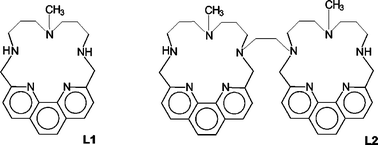Basicity and coordination properties of a new phenanthroline-based bis-macrocyclic receptor†
Abstract
The synthesis and characterisation of the new macrocyclic

* Corresponding authors
a
Dipartimento di Chimica, Polo Scientifico, Università di Firenze, Via della Lastruccia 3, Sesto Fiorentino, Firenze, Italy
E-mail:
andrea.bencini@unifi.it
b
REQUIMTE/CQFB, Departamento de Química, Universidade Nova de Lisboa, Monte de Caparica, Portugal
E-mail:
fjp@dq.fct.unl.pt
The synthesis and characterisation of the new macrocyclic

 Please wait while we load your content...
Something went wrong. Try again?
Please wait while we load your content...
Something went wrong. Try again?
C. Bazzicalupi, A. Bencini, A. Bianchi, L. Borsari, A. Danesi, C. Giorgi, C. Lodeiro, P. Mariani, F. Pina, S. Santarelli, A. Tamayo and B. Valtancoli, Dalton Trans., 2006, 4000 DOI: 10.1039/B603505A
To request permission to reproduce material from this article, please go to the Copyright Clearance Center request page.
If you are an author contributing to an RSC publication, you do not need to request permission provided correct acknowledgement is given.
If you are the author of this article, you do not need to request permission to reproduce figures and diagrams provided correct acknowledgement is given. If you want to reproduce the whole article in a third-party publication (excluding your thesis/dissertation for which permission is not required) please go to the Copyright Clearance Center request page.
Read more about how to correctly acknowledge RSC content.
 Fetching data from CrossRef.
Fetching data from CrossRef.
This may take some time to load.
Loading related content
